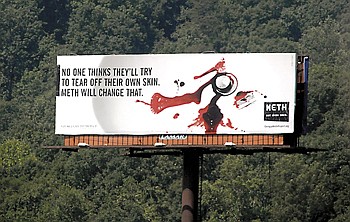Getting kids not to try a drug like meth, with all its negative stereotypes, doesn't seem like a hard sell.
After all, most people think of the drug as a deadly, teeth-rotting substance that causes instant addiction and leads its users to pick at scabby skin and stay up for days on end.
But according to recent data, more than one-third of Georgia teens still think the drug is OK to try once and roughly another quarter see nothing wrong with regular use.
So the challenge for the group behind the eye-popping TV and billboard ads that plead with teens never to try meth "not even once" is to make meth the most unappealing illegal drug around, group founders say.
"The point is to un-sell meth," said Jim Langford, the Georgia Meth Project's executive director. "We want to make the meth lifestyle something that is unattractive to young people while educating them about the risks."
It's costing the group about $6 million in ad space per year to spread that message, and Langford thinks members will keep it up for as many as five years to drill home their message.
But teens are hard to reach. Anti-drug campaigns have been around since the 1960s with limited success. In 2005, the Partnership for a Drug Free America stopped dissuading Americans from trying marijuana altogether and instead doubled efforts on emerging drugs such as methamphetamine and prescription drugs, according to a study by the University of Michigan.
Marijuana use steadily increased over the last 20 years despite popular campaigns like "Just Say No." In 1988, about 30 percent of Americans reported trying the drug once. In 2008, roughly 40 percent reported experimenting with the drug, according to the U.S. Department of Health and Human Services. Regular use stayed roughly constant at 6 percent of the population.
Different approach
But the meth ads are different, Langford said. The Meth Project has purchased high-priced primetime ad slots. It hired Hollywood film producers and skilled actors to play the parts of normal teens who were addicted to meth.
"These ads aren't going up in the dead of night like traditional public service announcements," Langford said. "They catch people's attention and stay in their heads."
In Montana, where the ads first began airing two years ago, the state ranked fifth in meth abuse in the United States. It now ranks 39th, according to Meth Project data.
And the ads are so scary, the Meth Project has gotten scattered complaints about their content, he said.
"We had people call and say that these ads were too graphic or inappropriate for their children to view," Langford said. "But the positive comments far outweigh the negative."
That sort of shock-value delivery might work, said one substance abuse counselor.
"Kids generally have some awareness, but they need to slow down to see the impact on their lives," said Brennan Francois, the CEO of Parkridge Valley Hospital, a Chattanooga in-patient behavioral health care provider. He previously worked with adolescents with substance abuse problems.
METH AND TEENSA survey of 1,000 Georgia teens earlier this year found:* 35 percent of teens felt little to no risk to trying the drug* 23 percent thought there was some benefit to trying meth* 23 percent thought there was no harm in using the drug on regular basis* 58 percent had never had a conversation with their parents about meth.Source: The Georgia Meth Project, Roper Center for Public Opinion Research
"Sometimes you can't see an immediate impact with kids, but if you can get them interested in some medium they are familiar with ... then you provide them with an opportunity to make an educated decision."
Teens experiment
A 2007 study by the U.S. Centers for Disease Control and Prevention found that nearly 7 percent of Georgia 12th-graders had tried meth. The U.S. Drug Enforcement Agency labels the state - and particularly Northwest Georgia - as a leading producer of the drug.
That's why Lee Shaw, chairman of the Meth Project, wanted to get involved. He oversees Shaw Foundation, the charitable arm of the Shaw Flooring family. Before being asked to lead the group, he knew little about the drug, he said.
In 2009, authorities raided 110 meth labs in Georgia. More than 500 were raided in Tennessee during the same time.
Authorities believe the overall number of labs is increasing as makers develop more mobile techniques.
The Meth Project estimates methamphetamine costs Georgians $1.3 billion in law enforcement costs, lost wages and social services.
"This is an opportunity where we can really help, where you can see the communities struggling to deal with this drug," said Shaw, who is also CEO of Atlanta-based Shaw Asset Management.
"Communities all across the state are struggling with this, but we're cutting through all the clutter and telling them this is not something you want to mess with."
